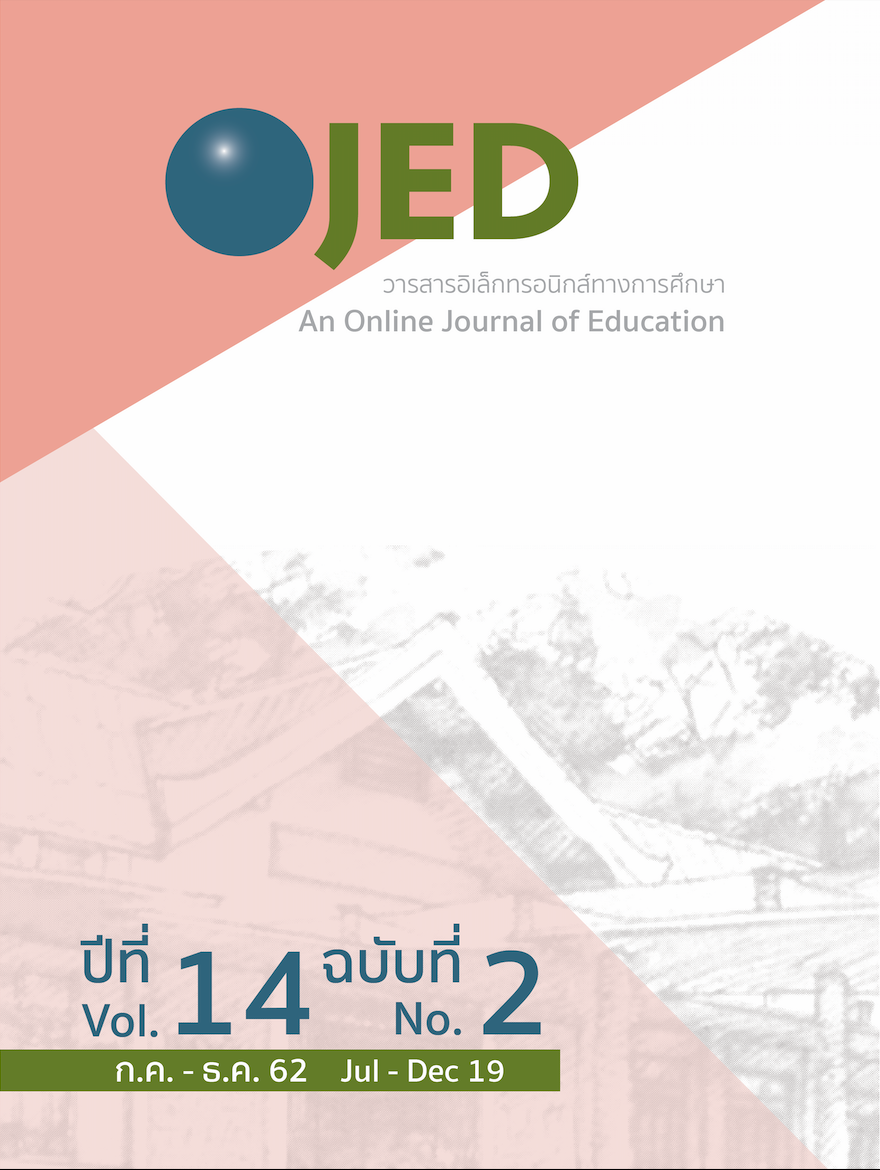VOCABULARY TEACHING USING PICTURE STORYTELLING TO IMPROVE ENGLISH VOCABULARY KNOWLEDGE OF GRADE 7 THAI STUDENTS
DOI:
https://doi.org/10.14456/ojed.2019.26Keywords:
VOCABULARY TEACHING, PICTURE STORYTELLING, VOCABULARY KNOWLEDGE, GRADE 7 STUDENTSAbstract
The objectives of this master project study were 1) to investigate what extent the vocabulary knowledge of the Grade 7 Thai students improved after attending vocabulary teaching using picture storytelling and 2) to explore the students’ opinions toward vocabulary teaching using picture storytelling. The sample included 40 Grade 7 students studying in a public Thai school. The instruments were English vocabulary knowledge pre-test and post-test and the questionnaire of the students’ opinion towards vocabulary teaching using picture storytelling. The data analysis used the statistics of paired-sample t–test, means and standard deviation. The results indicated that: 1) the post-test mean score was higher than the pre-test mean score at a 0.05 level of significance, and 2) the result of the questionnaire showed the average 4.1 of agreement which means students had positive opinions towards vocabulary teaching using picture storytelling.
References
Alqahtani, M. (2015). The importance of vocabulary in language learning and how to be taught. International Journal of Teaching and Education, III(3), 21-34.
Behmer, S. (2005). Literature review: digital storytelling: examining the process with middle school students. Proceedings of Society for Information Technology & Teacher Education International Conference (1), 822-827.
Bhakti, S. O. W., & Marwanto. (2018). Vocabulary Mastery by Using Storytelling. Script Journal: Journal of Linguistic and English Teaching, 3(1), 79-91.
Boonkongsaen, N., & Intaraprasert, C. (2014). Use of English vocabulary learning strategies by Thai tertiary-level students in relation to fields of study and language-learning experiences. English Language Teaching, 7(5).
Charkova, D., & Charkova, K. (2018). Exploring the connection between second language vocabulary learning strategies and vocabulary knowledge. International Online Journal of Education and Teaching (IOJET), 5(2), 235-250.
Dujmovic, M. (2006). Storytelling as a method of EFL teaching. Pergendira Journal, 3, 111-126.
Fariyatul, E., & Bandono, A. (2017). The use of value clarification technique-based- picture story media as an alternative media to value education in primary school. Harmonia: Journal of Arts Research and Education, 17(1), 68.
Hidayat, K. (2017). The effect of using flash card and picture story in vocabulary mastery to the seventh grader of Smp Pgri 1 Margatiga. PREMISE JOURNAL:ISSN Online: 2442-482x, ISSN Printed: 2089-3345, 5(2), 10.
Jitpaisarnwattana, N. (2018). Students’ Attitudes towards the Use of Digital Storytelling in Foreign Language Classroom: The Zimmer Twins Project. REFLections, 25(2), 59-75. Retrieved from https://www.tcithaijo.org/index.php/reflections/article/view/165359
Kalantari, F., & Hashemian, M. (2015). A story-telling approach to teaching English to young EFL Iranian learners. English Language Teaching, 9(1), 221.
Kirsch, C. (2012). Using storytelling to teach vocabulary in language lessons: does it work? The Language Learning Journal, 44(1), 33-51.
Nation, I. S. (2001). Learning vocabulary in another language. Cambridge: Cambridge University Press.
Nation, I. S. (2008). Teaching vocabulary: strategies and techniques. Boston, Mass: Heinle.
Noom-Ura, S. (2013). English-teaching problems in Thailand and Thai teachers’ professional development needs. English Language Teaching, 6(11).
Purwatiningsih, P. (2015). Improving speaking ability through storytelling technique by using picture series. Journal on English as a Foreign Language, 5(1), 57.
Priebe, S. J. Keenan, J. M., & Miller, A. C. (2010). How prior knowledge affects word identification and comprehension. Reading and Writing, 25(1), 131-149.
Schmitt, N. (2000). Vocabulary in language teaching. Cambridge. U.K: Cambridge University Press.
Downloads
Published
How to Cite
Issue
Section
License
Copyright (c) 2019 An Online Journal of Education

This work is licensed under a Creative Commons Attribution-NonCommercial-NoDerivatives 4.0 International License.




